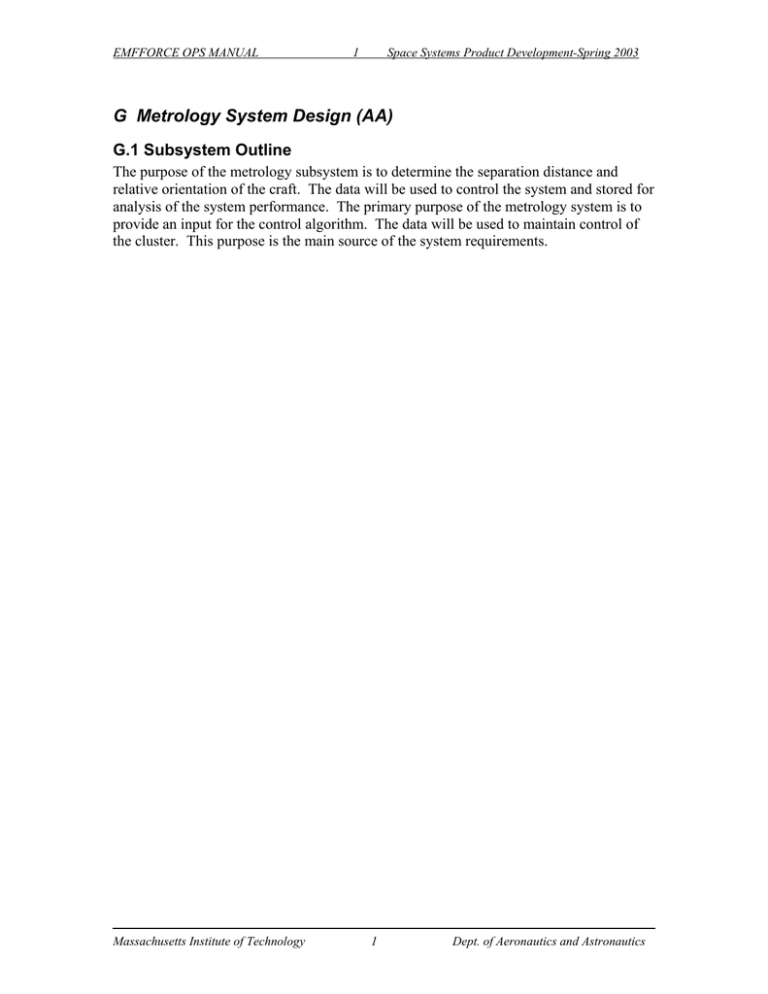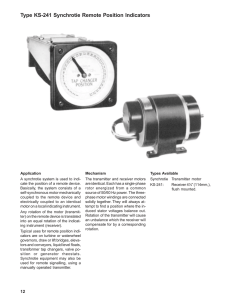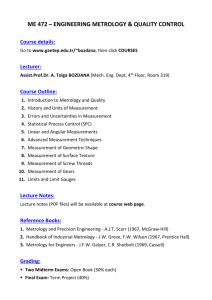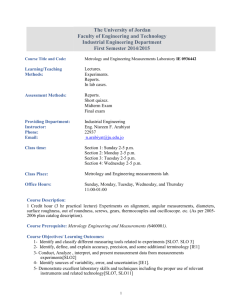Document 13479023
advertisement

EMFFORCE OPS MANUAL 1 Space Systems Product Development-Spring 2003 G Metrology System Design (AA) G.1 Subsystem Outline The purpose of the metrology subsystem is to determine the separation distance and relative orientation of the craft. The data will be used to control the system and stored for analysis of the system performance. The primary purpose of the metrology system is to provide an input for the control algorithm. The data will be used to maintain control of the cluster. This purpose is the main source of the system requirements. Massachusetts Institute of Technology 1 Dept. of Aeronautics and Astronautics EMFFORCE OPS MANUAL 2 Space Systems Product Development-Spring 2003 G.2 Requirements The metrology system is required to determine the position and orientation of the vehicles. The metrology system is also required to determine the angular rate of each vehicle. This data will be used to control the system and recorded for analysis. Specifically the metrology system must: • • • • Determine the separation distance of the vehicles to within 1cm Determine the bearing angle between vehicles to within 5 degrees Work at a maximum separation distance of 4m Return data at a rate of 1 Hz. Massachusetts Institute of Technology 2 Dept. of Aeronautics and Astronautics EMFFORCE OPS MANUAL 3 Space Systems Product Development-Spring 2003 G.3 Current System Design The current metrology system is legacy technology modified to suit our needs. The current design for the metrology system is a hybrid of the system used for project SPHERES and the system utilized by the Electronic Ink Corp. in their Mimio Electronic whiteboard. The design of the receivers is taken directly from SPHERES, since it had proven effective on that project and met our current system requirements. The transmitter is based on the design of the Mimio pen (transmitter). The Mimio transmitter proved to be more effective for location in 2D a plane (where as the SPHERES system was designed to work in 3D space). The original designs have been modified to suit the specific needs of project EMFFORCE, however, it can be assumed that any part of the design which is not explicitly described below is based solely on legacy technology. The metrology system uses triangulation of emitted ultrasonic signals to determine the location of the vehicles. Infrared emitters and receivers facilitate timing of the ultrasonic pulses. Each vehicle will be equipped with three omni-directional ultrasonic receivers, 1 omni-directional ultrasonic transmitter, and an array of infrared transmitters and receivers (to cover 360 degree line of sight). In this document, omni directional is taken to mean that the transmitters emit signals of the same amplitude and phase in all directions in the horizontal plane (360 degrees) and the receivers can sense a signal from any direction in a plane. This is not strictly “omni directional,” but since the test bed operates in 2D, the term is adequate. During one cycle of the sensing system, each vehicle will take turns emitting and receiving pulses and then calculate the position of the other vehicles by triangulation. The first vehicle will first emit an infrared pulse followed by an ultrasonic pulse at a known time later. The other two vehicles will first receive the infrared pulse followed by the ultrasonic pulse at each of the three receivers. The time difference between the reception time of the IR and Ultrasonic pulses will give time of flight for the ultrasonic pulse. This will be used to determine the distance of the transmitter from each of the receivers. A simple calculation will give the position of the transmitter. After the vehicles have the position data for the first vehicle, the second will take its turn to emit followed by the third. There is an inherent delay in this system. The ultrasonic pulse must be allowed to leave the test area before another can be emitted otherwise the first pulse might interfere with measurement of the subsequent pulses. Given the speed of sound at standard conditions and the current geometry of the system, the metrology team has calculated that it will require 23 milliseconds for a pulse to leave the test area before the next can be sent. As a result, a three-vehicle system will require 69 milliseconds to determine the orientation of all three vehicles. This is a delay inherent to the physics of the system and cannot be significantly changed. From this approximation and added margin for known and unknown factors, it is currently approximated that the metrology system will operate at 1 Hz. Massachusetts Institute of Technology 3 Dept. of Aeronautics and Astronautics EMFFORCE OPS MANUAL 4 Space Systems Product Development-Spring 2003 G.4 Hardware Component Design G.4.1 Structural Support The Structural support is designed to keep the other components in the proper orientation. It is necessary to keep the relative positions of the receivers fixed in order to calculate the position and orientation of the vehicle. Since the positioning of the receivers is so important, the metrology designed the structural support independently of the structure of the rest of the vehicle. The metrology system works by using differences in reception time at each of the receivers, thus it is important to keep them as far apart as possible. If the receivers are close together the difference in reception times will be very small. If the receivers are farther apart the average difference will be greater. Since errors in reading the receivers should be independent of receiver location, the greater difference between the reception times will make the errors less significant. The extent of this effect has not been calculated directly. The general assumption during design was that the receivers should be as far from the center of the vehicle without overhanging the edge of the vehicle. The structural support is attached to the vehicle using Velcro. For accurate position and angle measurement, the system needs to be aligned with the axis of rotation and center of mass of the vehicle (it was assumed that they would be in the same place, directly below the center of the support). It was assumed that axis of rotation might be hard to find or might change due to design changes so adjustments might be necessary. Velcro was used to make small adjustments easy. The support structure of the metrology system is a large Y cut from a single sheet of 1/8inch thick aluminum stock (a diagram is shown in Figure G.4-A). The structure was cut using the water jet. The legs each extend 0.38m from the center and are offset from each other by 120 degrees. The structure is attached to the top of the vehicle using Velcro. Specifically, the structure is attached to the lid of the cryogenic storage tank. The receivers attach at the ends of the beams and the transmitters attach at the center using Velcro. The Velcro is used for ease of adjustment. Massachusetts Institute of Technology 4 Dept. of Aeronautics and Astronautics EMFFORCE OPS MANUAL 5 Space Systems Product Development-Spring 2003 Figure G.4-A: Design of structural support to hold transmitter and receiver circuits. G.4.2 Receivers The ultrasonic and infrared receivers are mounted together on circuit boards at the ends of the support structure. The receivers consist of an ultrasonic and 2 infrared receivers mounted on a circuit board and a reflective cone. The board will amplify the ultrasonic signal, rectify it, and run it through a comparator to return a digital signal. The reflective cone will reflect ultrasonic waves coming from any direction into the ultrasonic receiver. This is to make unidirectional receivers into omnidirectional receivers. Reflecting the ultrasonic wave off the cone decreases the amplitude of the wave and thus will decrease the maximum range of the system. However, at this time, the range of metrology system exceeds the requirements so the loss due to reflection is negligible. The receiver circuit consists mostly of amplifiers for the ultrasonic receiver. The output of the ultrasonic emitter is limited so the range of the ultrasonic components must be accomplished at the receiver. The opposite is true of the infrared system. The receivers do have a high and low setting, however the high setting picks up the lights in the lab so the IR receivers must be used on low sensitivity. Range of the IR system is determined by the output of the transmitter (see below). Initially, the boards were to be printed circuits (see Sections 0 and G.9), however when the project was scaled back from three vehicles to two vehicles, it became more time efficient to build the circuits by hand. This has resulted in some variability in the boards but they all seem to work within requirements. The only method of adjusting the receivers is a variable resistor built in to the comparator on the receiver circuit. This resistor sets the sensitivity of the comparator and thus the sensitivity of the receiver. Massachusetts Institute of Technology 5 Dept. of Aeronautics and Astronautics EMFFORCE OPS MANUAL 6 Space Systems Product Development-Spring 2003 The 10K pot sets the voltage to pin 13, which in turn determines the sensitivity of the comparator. (See Figure 4-B below) If the voltage at pin 13 is set too low the receiver will never detect a signal (case 1 in Figure 4-B). If the voltage is set too high, the receiver will stay on constantly due to background noise (case 4). At the proper setting the output of the receiver (pin 14) will stay low, ground, until the receiver detects an ultrasonic pulse at which point the pin will change to high, 5 volts (case 2). When the signal stops, pin the output will drop back to low. If the voltage at 13 is set just over the correct value, the signal at 14 will be inverted, that is the voltage will stay high until it detects a falling signal which will make pin 14 drop to low before returning to high (case 3). Figure G.4-B: US receiver output calibration. Output of US receiver for a constant pulsing signal at various sensitivities. To calibrate a receiver, place the ultrasonic transmitter at the minimum operational range so that the signal will be the strongest signal encountered during operation. Turn on the transmitter and leave it pulsing. Measure the output of the receiver (pin 14 or the US output line) with an oscilloscope. Adjust the 10K pot until the signal almost switches to the oversensitive (pin stays high) position. For maximum range, set the sensitivity as high as possible without changing to the “always high” case. If maximum range is not required, it is suggested that the receivers be set on lower sensitivity. There is no clear cutoff between the sensitivity regimes. The appropriate voltage at pin 13 varies depending upon whether you are starting from a lower voltage or a higher voltage. The reflective cones used on the ultrasonic receivers are taken directly from parts donated by Mimio. The metrology team had originally decided to construct cones since there were not enough of the Mimio cones to supply three vehicles. De-scoping of the project (from three vehicles to two vehicles) made possible to use the Mimio cones. Section G.10 includes the preliminary design for custom made cones. Section G.10 is included in case more than 6 receivers are needed, or in case the Mimio cones are broken or lost. The cones are not currently attached to the boards (they are simply placed on top). While this design is not ideal, it is sufficient. A more permanent attachment should eventually be found. The receiver circuit boards have been mounted on pieces of Plexiglas to insulate the connections from the aluminum structural support. The boards are tied to the Plexiglas Massachusetts Institute of Technology 6 Dept. of Aeronautics and Astronautics EMFFORCE OPS MANUAL 7 Space Systems Product Development-Spring 2003 using small pieces of bare wire. This is an inelegant but effective solution. The boards are attached to the structure via strips of Velcro. The Velcro is adhered to the bottom of the Plexiglas. Velcro was chosen for ease of minor adjustments. G.4.3 Transmitters Each vehicle has a single transmitter unit placed at the center of the structural support. The transmitter emits both infrared and ultrasonic signals that can be detected by the receivers on the other vehicle(s). The current design calls for an infrared pulse followed by an ultrasonic pulse but the transmitter is capable of sending either signal at any time. Both channels are designed to take pulse inputs. Neither channel should ever receive a constant high signal or the circuit could overheat. The ultrasonic transmitters used for the metrology system were graciously donated by the Electronic Ink Corp (See Section G.9). They are the omni directional units used on the pens of the Mimio Electronic Whiteboard System. The top of a Mimio pen is used on each transmitter unit. The pen contains both the ultrasonic emitter and an array of infrared emitters. The emitters proved to be inadequate for our purposes so they are not used. The two extra wires coming from the Ultrasonic emitter are for the IR emitters. They should be left disconnected. Only the red and white leads are used and they are connected to the leads of the transformer. The design of the ultrasonic emitter circuit is taken directly from the designs provided by Mimio. The mosfets controlling the emitters have been replaced with the ultrafetts, which were left over from the power subsystem. The signal to the ultrasonic emitter should be a low signal that pulses to high. The ultrasonic emitter is capable of sustaining a constant (oscillating 40kHz) signal, but not at the voltage used to power it. The emitter currently runs at its max pulse voltage of 300 V. To run continuously it must be scaled down to 150 V. The infrared transmitter consists of four arrays of PDI-E804 high-power infrared emitters (see Figure G.4-C). Each array contains six emitters. The four arrays will ensure a detectable signal is sent in every direction in the horizontal plane. The transmitter would probably meet the range requirements with as few as four emitters per array, but it was more time efficient to use more emitters to ensure the system would work. Massachusetts Institute of Technology 7 Dept. of Aeronautics and Astronautics EMFFORCE OPS MANUAL 8 Space Systems Product Development-Spring 2003 Figure G.4-C: US40KT-01 40 kHz Omnidirectional Ultrasound Transmitter (left). PDI-E804 High-Power Infrared Emitters (right). G.4.4 Rate Gyros The metrology system utilizes rate gyros which were graciously donated by project SPHERES, specifically, the BEI Gyrochip II. The axis of the gyro must be parallel to the axis of rotation of the vehicle and the gyro will connect to the power system and to the avionics tattletale. Otherwise, the gyro can be placed anywhere on the vehicle. A simple resistor-capacitor (RC) circuit has been added between the gyro and the tattletale to reduce high frequency noise. The noise seems to come from the reaction wheel motor but it is difficult to determine exactly. The values of the RC circuit are a 16000-Ohm resistor and a 1-microfarad capacitor. These values were calculated assuming a sample rate of 10 Hz. This gave a value of RC = 1/60. The resistance was chosen to be well under the input resistance of the tattletale (which was unknown but assumed to be around 10^6 Ohms). The exact values were chosen based on what was readily available in the lab. The connector for the rate gyro board has four terminals. There are two output leads; one is the direct output before going through the RC circuit. The other is the corrected output, which is first filtered by the RC circuit. The planned stationary beacon will not be utilized. Functionally, it would resemble the transmitters on each vehicle. The beacon would consist of one transmitter unit mounted on a stand that is the same height as the vehicles. The stationary beacon would provide data that could be used to determine the inertial position of the vehicles. The current system design does not call for a stationary beacon as the vehicle does not have inertial control authority. This requirement may change, but it is assumed that the stationary beacon will not be built. This section has been retained for the sake of completeness. Massachusetts Institute of Technology 8 Dept. of Aeronautics and Astronautics EMFFORCE OPS MANUAL 9 Space Systems Product Development-Spring 2003 G.5 Testing/Verification G.5.1 Hardware Testing The following hardware tests have been completed. The results are summarized below. Range test A transmitter was placed near a receiver and slowly moved away until the signal was undetectable. An oscilloscope was used to read outputs of infrared and ultrasonic receivers. The range of the transmitter and receivers is roughly four meters. Time of flight measurement test An oscilloscope was used to read outputs of infrared and ultrasonic receivers. The time difference between reception of infrared and ultrasonic signals was compared to the distance between receiver and transmitter. The relation proved to be linear over the test range. Timing error due to angular offset This test consisted of two parts. First the transmitter was rotated to verify that transmitter orientation caused no variation in signal reception. Then the transmitter was placed one meter from receiver at various positions around the receiver. The time of flight was compare for each position to determine if angular position caused any change in reception time. The time of flight did not vary with angle. Thus there seems to be no effect on range determination due to angles changes. The tests described above were preliminary tests to verify the functionality of the metrology hardware. Similar tests were run with the full hardware setup running on the metrology software. The data for these tests is included in the metrology software section. G.5.2 Interfaces G.5.2.1 Communications With the current design, each vehicle is only able to determine its own position and orientation relative to the other vehicles. Therefore, the angular orientation of the other vehicles is transmitted over the communications system so the control algorithm will have all of the information required to control the vehicles. G.5.2.2 Avionics The hardware for the metrology system is connected to the avionics board. The avionics board contains a tattletale board dedicated to the metrology system. There are two output pins on the avionics board to the transmitter. The outputs include one ultrasonic out and one IR out. There are six inputs on the avionics board from the metrology subsystem. The inputs on the avionics board include three infrared inputs and three ultrasonic inputs. Massachusetts Institute of Technology 9 Dept. of Aeronautics and Astronautics EMFFORCE OPS MANUAL 10 Space Systems Product Development-Spring 2003 All of these pins are connected to ribbon cable, which connects to the metrology system. There is an OR-gate chip on the avionics board that was intended to combine the signals from the infrared receivers. The gate proved unnecessary and may have been the cause of some of the noise in the system. The chip has been removed and replaced by wire that connects all of the Infrared inputs. The IR input pin stays high normally and a signal received by any one IR receiver will set the IR input pin low. G.5.2.3 Structures The metrology subsystem must be mounted on the vehicles in such a way that it has an unobstructed 360-degree view so that it can locate the other vehicles. Obstructions will make “blind spots” where the other vehicles will be undetectable. To prevent blind spots, the metrology system is mounted on top of the vehicle. The support structure is attached to the top of the liquid nitrogen tank using Velcro. Again, Velcro was used for ease of adjustment. G.5.2.4 Power The metrology system requires five-volt DC power and a ground line. The current draw should be minimal. The metrology system is connected to the power system via ribbon cable. All of the power and ground leads to each component of the metrology system have been soldered together so that only one power and one ground pin are required. The power leads are part of the same cable as the signal leads. G.5.3 Subsystem Mass Table G.5-A: Mass Budget. Component Reflective Cone Receiver board* Transmitter Board* Structure Rate Gyro Mass each (g) 40 38 78 514 48 Vehicle Total Mass per Vehicle (g) 120 114 78 514 48 874 *Including Plexiglas insulator/support and Velcro attachment The masses above were determined by weighing the components on a digital scale. The masses of each component vary (especially the circuit boards). The values above represent the highest value of the measured components. The variations were usually only a few grams. Massachusetts Institute of Technology 10 Dept. of Aeronautics and Astronautics EMFFORCE OPS MANUAL 11 Space Systems Product Development-Spring 2003 G.6 Receiver Cirrus Layout Reflective Cone US Receiver Pow US Gnd IR IR Receivers Figure G.6-A: Receiver Mounted on Structure support (Left) and Top View of Receiver Circuit with Cone and Wires Disconnected (Right) Massachusetts Institute of Technology 11 Dept. of Aeronautics and Astronautics EMFFORCE OPS MANUAL 12 Space Systems Product Development-Spring 2003 Figure G.6-B: Metrology System mounted on Vehicle G.7 Transmitter layout Figure G.7-A: Transmitter board mounted on structural support Massachusetts Institute of Technology 12 Dept. of Aeronautics and Astronautics EMFFORCE OPS MANUAL 13 Space Systems Product Development-Spring 2003 IR Emitter Array IR Emitter Array Pow US Gnd IR IR Emitter Array US Emitter US Emitter Support Figure G.7-B: Detail view of Transmitter Massachusetts Institute of Technology 13 Dept. of Aeronautics and Astronautics EMFFORCE OPS MANUAL 14 Space Systems Product Development-Spring 2003 G.8 Receiver Circuit Design Figure G.8-A: Receiver Circuit Schematic Note: this Diagram is incorrect since the OR-Gate is no longer used. Also the IR receivers connect to pin 4 and ground connects to pin 3. Massachusetts Institute of Technology 14 Dept. of Aeronautics and Astronautics EMFFORCE OPS MANUAL 15 Space Systems Product Development-Spring 2003 G.9 Transmitter Circuit Design Figure G.9-A: Transmitter Circuit Schematic Massachusetts Institute of Technology 15 Dept. of Aeronautics and Astronautics EMFFORCE OPS MANUAL 16 Space Systems Product Development-Spring 2003 Figure G.9-B: Transmitter Circuit Schematic Note: Figure G.9-B is incorrect because the IR output is on 4 and ground connects to pin 3. The original OrCAD file for this circuit has been lost due to computer error. G.10 Reflective Cone Design The current metrology system utilizes reflective cones (see Figure G.10-A) taken directly from a Mimio Electronic whiteboard system. The cones were graciously donated by The Electronic Ink Corporation. We currently have enough cones for 2 metrology systems with one backup. However, we originally planned to construct our own cones. This section gives information on how to construct such a cone in case more metrology systems are required or replacement parts are needed. Alternately, it might be more efficient to purchase a Mimio system and use it for parts (though this seems wasteful). The cones come from the receiver (base unit) of the Mimio system. Massachusetts Institute of Technology 16 Dept. of Aeronautics and Astronautics EMFFORCE OPS MANUAL 17 Space Systems Product Development-Spring 2003 Figure G.10-A: Reflective cone. Ultrasonic signals coming from any direction reflected into the receiver. The shape of the cone is defined by rotating a portion of a parabola about the y-axis. The constants of the equation were determined using measurements of the reflective cones used in the Mimio Electronic Whiteboard system. The equation of the parabolic section defines the shape of the side of the reflective cones: y 2 = 4(7.059mm)( x + 4.906mm) x = 0mm → x = 39mm Equation G.10-1 This equation was calculated using the measurements in Figure G.10-B. The measurements were taken from a Mimio cone using digital calipers. Figure G.10-B: Reflective cone measurements. Measurements used to calculate the equation of the cone. Massachusetts Institute of Technology 17 Dept. of Aeronautics and Astronautics






